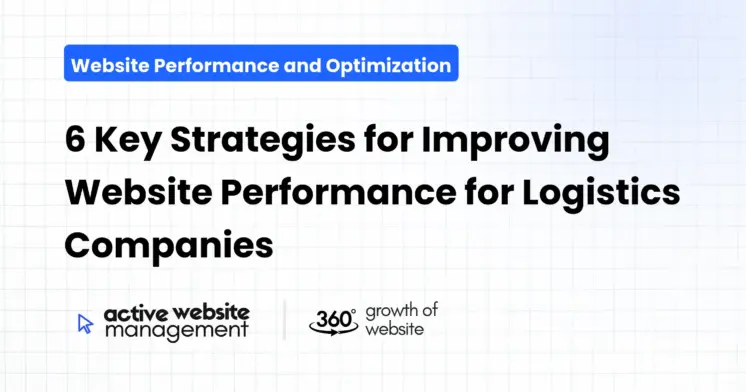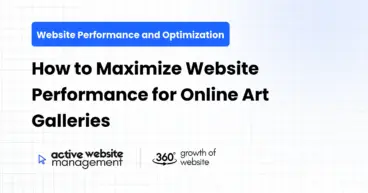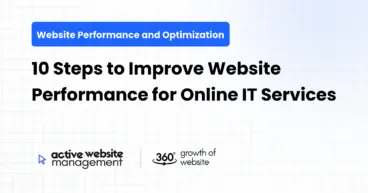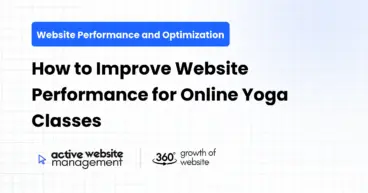January 31, 2025
16 min read
In today’s fast-paced world of logistics, a slow-loading website isn’t just an inconvenience; it’s a deal-breaker. Potential clients are looking for speed, efficiency, and reliability—the very traits your company likely prides itself on. A clunky, sluggish website sends the opposite message, pushing valuable leads to your competitors. This article dives deep into six essential strategies that can transform your logistics company’s website from a liability into a powerful lead-generating and customer-retention tool. We’ll explore how to tackle common website speed hurdles, optimize your platform for better user experience, and ensure your digital presence reflects the quality of your services. Let’s get started on making your website a high-performing asset.
1. Optimizing Images: A Picture is Worth a Thousand (But Not if It’s Slowing You Down)
Images are vital for any website. They break up text, make content more engaging, and show off your fleet, facilities, and team. However, large, unoptimized images are one of the biggest culprits behind slow loading times. They can balloon your page size, making users wait—and wait—and wait. This waiting game can lead to frustration, driving potential clients away before they even get a chance to learn about your services. This is one area where focusing on logistics site speed makes a tangible difference.
Why Image Optimization is Crucial
- Improved Load Times: Smaller files mean faster page loads, keeping visitors engaged.
- Enhanced User Experience: No one likes to wait; fast-loading pages lead to happy users.
- Better SEO: Search engines favor fast-loading websites, boosting your ranking and visibility.
- Reduced Bounce Rate: Visitors are more likely to stay on a website that loads quickly.
Practical Steps for Image Optimization
- Choose the Right File Format:
- JPEG: Great for photos due to their smaller file sizes and good compression.
- PNG: Ideal for graphics and images with transparency (logos, icons). They tend to be larger than JPEGs.
- WebP: The modern standard, offering excellent quality and small sizes, but not yet supported by all browsers. Use it where possible and include JPEGs or PNGs as a fallback.
- Resize Images: Never upload images that are larger than they need to be. Use a tool like Photoshop, GIMP, or a free online image resizer to make images the right size for where they’ll be displayed on your website.
- Compress Images: Use tools like TinyPNG, Compressor.io, or ImageOptim to compress images. These tools reduce file sizes without significantly impacting image quality.
- Use a Content Delivery Network (CDN): A CDN stores copies of your website’s files on servers around the globe. When a user visits your site, the content is delivered from the closest server, ensuring fast load times for everyone, no matter where they’re located.
- Implement Lazy Loading: Lazy loading means images are only loaded as they come into the user’s viewport. This significantly reduces the initial page load time and improves the perception of speed.
- Responsive Images: Serve different image sizes depending on the device being used (desktop, tablet, mobile). This ensures optimal image size for each display, further reducing unnecessary loading.
By paying attention to these details, you’ll see a dramatic improvement in your logistics site speed. This will not only make your visitors happy but also signal to search engines that you care about user experience, which will boost your overall search performance.
Don’t Just Maintain Your Website—
Grow It using Active Website Management! Don't Wait for Growth—Accelerate It with Active Website Management
2. Streamlining Code: Clean Code Equals a Fast Website
Just like a well-oiled machine, a website needs efficient and clean code to run smoothly. Overly complex, bloated code can significantly slow down your site’s loading speed, affecting your overall user experience and SEO performance. Think of it as unnecessary clutter that your website’s browser has to sift through every time someone visits. For logistics companies, which rely on seamless communication and data exchange, this is especially critical. Improving your freight website performance starts under the hood with your website’s code.
Why Code Optimization Matters
- Faster Load Times: Lean, optimized code results in faster load times for all users.
- Better User Experience: A quicker website makes browsing more enjoyable and efficient.
- Improved SEO: Search engines reward fast sites, which in turn will improve your ranking.
- Reduced Server Load: Efficient code reduces server stress, cutting down on resource consumption.
Practical Steps for Code Optimization
- Minify CSS, JavaScript, and HTML: Minification is the process of removing unnecessary characters (spaces, comments, line breaks) from your code. This reduces file sizes and speeds up load times. Tools like UglifyJS or CSSNano can assist with this.
- Remove Unused Code: Look for and eliminate any code that is no longer needed. This reduces the overall size of your files. Unused plugins and scripts can also cause problems. Conduct an audit of your site and remove those that aren’t performing a necessary function.
- Compress Files with Gzip Compression: Gzip compression is a method of compressing data that can drastically reduce the size of your CSS, JavaScript, and HTML files. This speeds up transfer times.
- Use Asynchronous Loading: When your browser downloads files, it does it in order. Asynchronous loading, by contrast, allows files to load at the same time, rather than being blocked by other files. This makes the overall page load faster. It allows non-critical scripts to be downloaded in the background without affecting the display of the page itself.
- Optimize Database Queries: If your site uses a database (for example, if you have a quoting form that writes to the database), ensure that those queries are optimized for performance. Long, slow queries can dramatically impact page performance. Regular database maintenance is crucial.
- Code Review: Schedule periodic code reviews to maintain clean, efficient code, and identify opportunities to improve. If you don’t have in-house development resources, hire a professional to take a look at the underpinnings of your site.
By optimizing the underlying code, you not only make your website faster and more reliable but also lay a solid foundation for future scalability and growth. The result is an improved user experience that will resonate with your target audience in the logistics sector.
3. Leveraging Browser Caching: The Secret Weapon for Speed
Imagine a library. When you borrow a book, you might return it to the shelf the next day, or you might keep it for a while if you think you’ll use it again. Browser caching operates on the same principle. It stores copies of your website’s static resources, like images, CSS files, and JavaScript, in the user’s browser. When a user returns to your site, the browser loads these resources from its local cache rather than downloading them again from your server. This significantly reduces load times, resulting in a faster and more seamless user experience for both first-time and returning visitors, improving your overall freight website performance. This is a huge help to users because if they’ve been to your site once, it makes the next visit quicker.
Why Browser Caching is Essential
- Faster Load Times for Returning Visitors: Caching reduces server load, resulting in faster load times for users who visit your site repeatedly. This can make a huge difference to returning customers.
- Reduced Server Load: By delivering assets from cache, the server doesn’t have to deliver all the website assets each time.
- Improved User Experience: Quicker page loads lead to happy users who are more likely to engage with your site.
- Lower Bandwidth Usage: Reduced data transfer also reduces bandwidth costs for both you and your users.
Practical Steps for Implementing Browser Caching
- Set Proper Cache Headers: Use server-side configuration (.htaccess file, Nginx configuration) to set cache headers for static resources. This tells the browser how long to store a resource before checking for an update. Consider using longer cache times for things that don’t change often, like your logo.
- Cache-Control: This header allows you to specify a variety of caching policies, like ‘public,’ ‘private,’ ‘no-cache,’ and ‘max-age.’
- Expires: This header sets an exact date and time for when the cached resource should expire. It’s less flexible than ‘Cache-Control’ but is still useful for older browsers.
- Etag: The ‘Entity Tag’ is a unique identifier assigned to a resource so that the browser can check if the resource has been changed without downloading it again.
- Use Caching Plugins or Extensions: If you’re using a CMS like WordPress, look for reliable caching plugins. These often include a variety of optimization features including page caching and object caching.
- Monitor Caching Efficiency: Tools like Google PageSpeed Insights will tell you whether you have implemented browser caching correctly. Check regularly, and adapt your caching rules as necessary.
- Educate Your Team: Ensure your team knows what browser caching is and how it works so that they can manage changes to the site efficiently.
Implementing proper browser caching is like having a personal fast lane for returning visitors. It’s a subtle but powerful change that will dramatically improve the user experience and boost your freight website performance. This will translate to higher engagement and, ultimately, more business for your logistics company.
4. Mobile Optimization: A Must-Have in the Modern Era
In today’s world, many people use their phones to do most of their online research, including in the logistics industry. Having a website that isn’t optimized for mobile devices is the same as having a storefront that only opens when a visitor is wearing a certain kind of hat. It’s not inclusive, and will put people off. The mobile experience is critical for potential clients on the go, whether they’re checking rates, tracking shipments, or contacting customer service. A mobile-unfriendly website, however, is a disaster waiting to happen, costing you valuable leads and creating a poor impression.
Why Mobile Optimization is Non-Negotiable
- Increased Mobile Traffic: More people than ever access the internet using their mobile devices. If your website doesn’t cater to them, you’re missing out on significant traffic.
- Improved User Experience: Mobile-optimized sites offer a smooth experience on smaller screens, resulting in happier, more engaged users.
- Better SEO: Google uses mobile-first indexing, which means it crawls and indexes the mobile version of your website first. A mobile-friendly website will boost your search rankings.
- Competitive Advantage: With many businesses still lagging on mobile optimization, doing it right will give you an advantage in the competitive logistics market.
Practical Steps for Mobile Optimization
- Responsive Design: Employ a responsive design framework. This means your website adapts seamlessly to different screen sizes without requiring a separate mobile website. This ensures a consistent look and feel across all devices.
- Touch-Friendly Navigation: Ensure buttons, menus, and form fields are easy to tap on mobile screens. Use a finger-sized target (around 48 pixels wide). Don’t require precise finger placements.
- Readable Fonts: Use font sizes that are easy to read on smaller screens. Avoid small, cramped text, and select fonts that provide good readability and contrast.
- Optimized Layout: Ensure your website is displayed correctly. Avoid overly long lines of text that stretch across the screen, and ensure that the most important content is near the top.
- Mobile-Friendly Images: Images should be resized for mobile screens to reduce bandwidth usage, and should be compressed as discussed earlier.
- Fast Loading Speed: Focus on speed optimization, because mobile users are likely on slower connections or using their mobile data. Don’t expect them to wait.
- Mobile-First Thinking: When designing content and features, begin with the mobile user in mind. Prioritize the features that are most important on the mobile experience, and think of the desktop as a large version of the mobile experience.
- Testing on Multiple Devices: Make sure your website displays and functions as intended on a variety of phones and tablets. Test often and ensure all features work correctly.
Mobile optimization is not a bonus; it’s a cornerstone of a high-performing website in today’s logistics landscape. By prioritizing the mobile user, you’ll not only see improvements in your website metrics, but will also show clients that you are a cutting-edge company that understands and caters to its customers.
Don't Wait for Growth—Accelerate It with
Active Website Management Don't Wait for Growth—Accelerate It with Active Website Management
5. Content Delivery Network (CDN): Global Speed for a Global Industry
Logistics is often a global business, dealing with clients and partners in diverse locations. If your website’s server is located in one particular area, users from other parts of the world may experience slower load times, which is obviously bad for business. This is where a Content Delivery Network (CDN) steps in, acting as a network of geographically dispersed servers that distribute your website’s content. This significantly reduces latency and makes your site load fast for all users, regardless of their location, greatly improving your overall transport platform optimization. Think of it as strategically positioning hubs around the world that hold copies of your website’s assets. This allows users to retrieve content from a server near them, rather than having to reach a single, centralized server in one location.
Why a CDN is a Game-Changer
- Reduced Latency: CDNs minimize the distance between the user and the server, resulting in faster load times.
- Faster Load Times: This is critical for users all over the world. With a CDN, your website performs consistently and quickly for users no matter where they are.
- Reduced Server Load: By distributing content through multiple servers, a CDN reduces the strain on your primary server, improving stability and efficiency.
- Enhanced User Experience: Fast loading times lead to a better user experience, which in turn drives conversions and customer satisfaction.
- Improved SEO: Search engines prefer faster-loading websites and will reward them with better rankings.
- Increased Reliability: By using a CDN, if one server goes offline, another can handle the request, ensuring your website is always available.
Practical Steps for Implementing a CDN
- Choose the Right CDN Provider: Research different CDN providers based on your budget, needs, and coverage. Some popular options include Cloudflare, Akamai, Fastly, and Amazon CloudFront.
- Integrate Your Website with the CDN: Follow the instructions provided by your CDN provider to connect your website. This typically involves updating your DNS records to point to the CDN servers.
- Configure Caching Rules: Configure caching rules to ensure that static content, like images, JavaScript, and CSS files, is cached efficiently.
- Monitor Performance: Regularly monitor your CDN’s performance and make necessary adjustments to ensure optimal speed and efficiency. Most CDN providers offer dashboards that allow you to view analytics.
- Utilize Edge Caching: Many CDNs utilize edge caching, which means the closest server to a user also retains the most frequently-requested data. This will make your website’s overall performance even faster.
- Consider Using Multiple CDNs: For large enterprises, having more than one CDN can provide added redundancy and can distribute traffic better to different parts of the world.
By implementing a CDN, your logistics company can offer a fast, seamless online experience to users anywhere in the world, giving you a competitive edge in today’s increasingly global marketplace. This will make sure that, no matter where the user is, your website will be just as quick and reliable.
6. Active Website Management: The Ongoing Process of Optimization
It’s not enough to implement these optimization strategies once; website performance is an ongoing project, and it requires constant monitoring, adjustment, and maintenance. It’s like owning a high-performance vehicle; you can’t just buy it and assume it’ll run perfectly without any upkeep. Similarly, your website needs consistent, active management to maintain its performance, and to keep up with changing technologies and user needs. This isn’t a one-time fix; it’s an integral part of your overall business strategy. This is where a service like Active Website Management can be invaluable.
Why Active Website Management is Crucial
- Consistent Performance: Regular monitoring and maintenance keep your website running smoothly and quickly.
- Adaptability: You can respond to changes in the online world (new browser versions, search engine algorithms, etc.).
- Security: Regular updates and maintenance will also help secure your website from threats.
- Improved User Experience: Continual improvements keep your website user-friendly.
- Enhanced SEO: Consistent maintenance ensures your website remains attractive to search engines.
- Peace of Mind: Active management allows you to focus on your core business activities while your website is in good hands.
Key Aspects of Active Website Management
- Regular Performance Monitoring: Track key metrics such as page load times, bounce rate, and server response times. Tools like Google Analytics and Google PageSpeed Insights are invaluable for this.
- Routine Website Backups: Back up your website regularly to protect against data loss. Automate this process if possible.
- Software and Plugin Updates: Keep your website’s core software, themes, and plugins up to date to ensure optimal security and performance. Many security risks can be mitigated by keeping software current.
- Security Checks and Updates: Perform regular security checks to protect against threats. Stay up-to-date on potential security risks.
- SEO Monitoring and Optimization: Continuously monitor and optimize your SEO efforts. Use tools to help identify and rectify any errors that may impede your search engine rankings.
- Content Updates: Regularly refresh and update content to keep your website relevant and engaging.
- User Feedback Analysis: Analyze user feedback to identify areas for improvement. User feedback can reveal shortcomings that analytics often don’t show.
- Proactive Problem Solving: Address issues before they impact your website’s performance or user experience. Be proactive to ensure your site is running optimally, rather than reactive to things when they fail.
- Dedicated Support Team: Having a team that is dedicated to website maintenance makes managing your site easier. Even if that team is not internal to your company, having access to experienced help is a major benefit.
By embracing active website management, your logistics company will not only see a sustained improvement in website performance, but you will also have the ongoing security and peace of mind that comes from knowing your site is in good hands. It’s not enough to build a high-performance website; you need to maintain it over time, as well.
Conclusion
In the fast-paced logistics industry, a high-performing website is more than just a nice-to-have—it’s a necessity. By implementing these six key strategies—optimizing images, streamlining code, leveraging browser caching, prioritizing mobile optimization, using a CDN, and embracing active website management—your logistics company can transform its website into a powerful asset that drives growth, enhances user experience, and increases your overall success. It’s an investment that pays dividends in the form of happy customers, improved search engine rankings, and a solid online presence that reflects your company’s commitment to excellence. Don’t let a slow website hold your business back any longer; take these steps today and put your best foot forward in the digital world.







